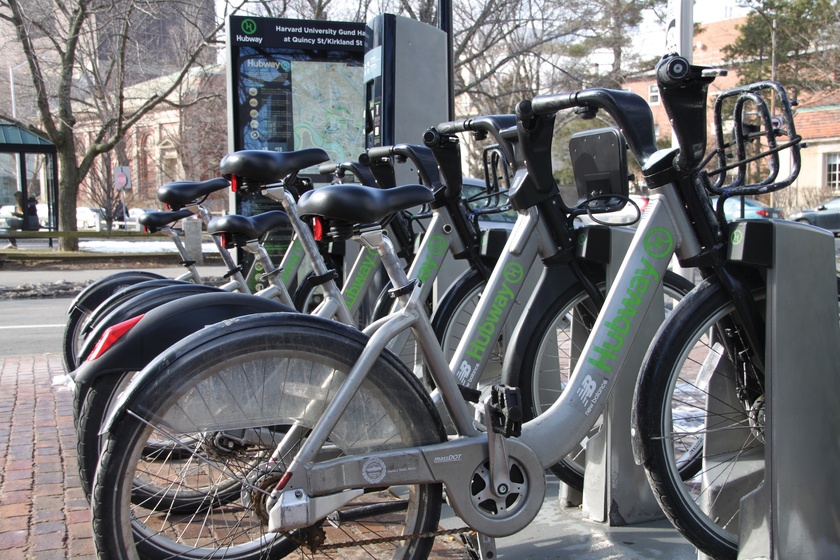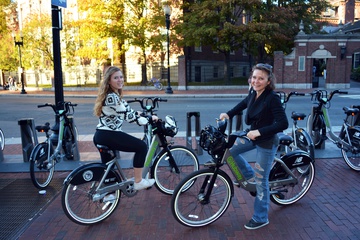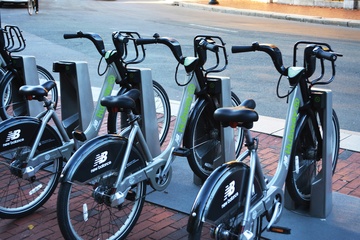I should have been wearing a helmet; that much was clear.
Instead, I clutch at my brakes, desperately trying to avert crisis. It is already too late: my front wheel impacts the first ridge at full speed, and I jolt forwards, nearly launching over the handlebars. Beneath the oak tree towering out from my left extends a web of roots, cutting veins into a section of pavement already battered and scarred by years of the Boston winter. I brace the balls of my feet against the pedals, attempting to absorb as much shock as I can as Hubway bike #B00558 and I bounce our way down Cedar Street.
I catch a reprieve when I turn onto the much smoother Washington Street and pedal my way up to my destination: Roxbury’s Malcolm X Park.
I dock #B00558 at the Hubway Station on Martin Luther King Jr. Boulevard and enter the park to find Kevin C. Singleton manning a grill amidst his friends. “The Hubway bikes?” one of them exclaims, incredulously. “I ain’t ever used those.”
Established in 2011, Hubway is a bike sharing network owned by the cities of Boston, Cambridge, Somerville and Brookline. According to its website, Hubway reports a monthly ridership of 150,000 rides per month.
Singleton flips the burgers with one hand and pulls a cigarette from his mouth with the other. “I don’t know if you know the history of this street,” he answers, as much to his friend as to me, “but it was built to connect with Route 128 back in the day. But they were taking people’s land, so they stopped it, and now it’s just a road that goes to nowhere.”
He looks at the bike station at the corner of the park. “There’s no bus that comes through this area,” he says. As far as Singleton is concerned, Hubway provides a flexible supplement to Boston’s transit network, an extension for hard-to-reach areas like MLK Jr. Boulevard.
Disparate coverage is hardly his only grievance with the MBTA. “With the fare hikes on the train, it’s almost a thousand dollars a year, and a lot of people can’t afford that!” he says.
For Singleton, these limitations demand an alternative capable of servicing disconnected areas like his neighborhood in Roxbury that still remains accessible to the lower-income communities that frequently populate them.
Cambridge Transportation Program Manager Bill Deignan hopes that the Hubway bike share program can fill this void. “Bike share is a way to make biking more widely available to people in a form that’s like a mini transit system,” he explains.
Since 2011, Hubway has expanded to include more than 160 stations across Boston, Somerville, Cambridge, and Brookline. “People may not have access to a bike or they may not want to bother with maintaining their own bike, so this gives them the ability to ride as often as they like within those four communities year round,” Deignan adds.
One crucial aspect of this “mini transit system” is affordability. On Jan. 19, 2018, Hubway announced its “SNAP Card to Ride Program”, a first-of-its-kind effort to provide reduced cost memberships to participants in the Supplemental Nutrition Assistance Program, more commonly known as food stamps. While typical Hubway memberships cost either ten dollars a month or $99 annually, SNAP Card to Ride offers five dollar monthly and $50 annual memberships, featuring unlimited 60 minute rides.
“Over the coming months we are looking to expand [the discount] for members of additional income-eligible programs,” Deignan adds. In the spring, for example, Hubway plans to offer the same discount to WIC and MassHealth participants, Pell Grant recipients, and public housing residents. “We’re hoping that bike share can become a more affordable option for a greater number of people,” he concludes.
Even with the SNAP Card to Ride program, though Hubway will have to overcome the widely held-perception that it is inaccessible to low income consumers.
Roxbury, where Singleton and his friends reside, is home to 12.9 percent of Boston’s impoverished population. And despite Singleton’s assessment of his local station’s utility, when I park my bike there, I find it deserted, seemingly unused. Indeed, usage data reported by Hubway places the most popular stations near MIT, South Station, and Central, Kendall, and Harvard Squares.
Riding bike #B00310 into Fenway, the situation seems to resemble that of Roxbury—disuse. “No, I can’t afford that,” Jessica S. Ramirez says, replying immediately when I ask if she uses Hubway. She reclines, glancing out over Justine Mee Liff Park. “[There’s] no convenient way to travel around here.”
Andre J. Wilson, another Fenway resident, gives his two cents. “If it was cheaper,” he interjects, “I would get one of them bikes and ride over here from Ruggles, you know what I’m saying?”
“It would be a lot faster too!” Wilson adds. “You don’t got to stop for red lights.”
With 43.7 percent of its residents living in poverty, Fenway ranks among Boston’s most impoverished neighborhoods. Yet while Wilson and Ramirez in many ways represent the SNAP Card to Ride program’s target demographic, both said they were unaware of the new initiative.
Hubway’s effort to expand low-cost services to income eligible consumers represents a bold and creative measure to expand transit access to low income consumers and disconnected neighborhoods; however, the system will need to market itself to people like Wilson, who still doubt its affordability.
“If it was cheaper, I’d use them for sure,” Wilson confirms.
Magazine writer Andrew W. Aoyama can be reached at andrew.aoyama@thecrimson.com. Follow him on Twitter @AndrewAoyama.





